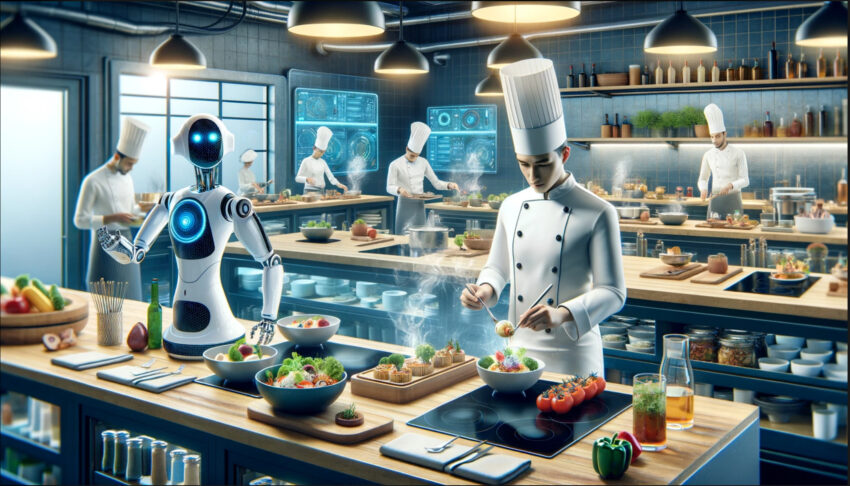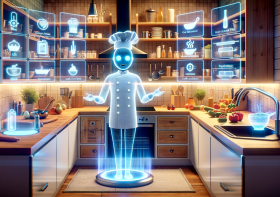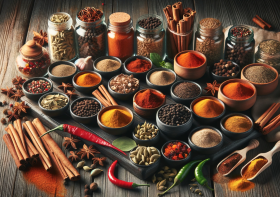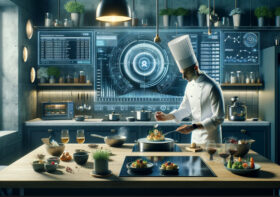The Rise of AI Chefs: Are They the Future of Restaurants?

Welcome to the culinary revolution! “The Rise of AI Chefs: Are They the Future of Restaurants?” is not just a catchy headline; it’s a peek into an exciting future where technology meets gastronomy.
These sophisticated machines are changing the way we think about food preparation and the restaurant experience as a whole. In this blog post, we’ll jump into the world of AI chefs, exploring their capabilities, the impact they’re having on the culinary world, and whether they truly are the future of restaurants.
What Are AI Chefs?
AI chefs, also known as robotic chefs or cooking robots, are advanced machines equipped with artificial intelligence and robotic arms designed to prepare and cook food autonomously. These machines are programmed with a wide range of cooking techniques and recipes, allowing them to replicate the work of human chefs in commercial kitchens. They can chop, sauté, grill, and even plate dishes with precision and consistency.
How Do AI Chefs Work?
AI chefs operate using a combination of hardware and software technologies. Here’s a simplified breakdown of how they work:
- Sensors and Cameras: AI chefs are equipped with sensors and cameras that allow them to perceive their surroundings. These sensors can detect ingredients, utensils, and cooking equipment.
- Artificial Intelligence: The AI component of these machines is responsible for understanding recipes, cooking techniques, and human preferences. It can access a vast database of recipes and cooking instructions, allowing it to create a wide variety of dishes.
- Robotic Arms: The robotic arms of AI chefs are equipped with a variety of tools, such as knives, spatulas, and ladles. These arms can perform precise movements required for cooking, from chopping vegetables to flipping pancakes.
- Machine Learning: AI chefs can learn and adapt over time. They can improve their cooking skills by analyzing data from previous cooking sessions and user feedback. This helps them refine their techniques and produce better results.
- Integration: AI chefs can be integrated into restaurant kitchens alongside human chefs. They can work independently or in collaboration with their human counterparts, depending on the restaurant’s needs.
The Advantages of AI Chefs
AI chefs offer several advantages that make them an appealing choice for restaurants looking to improve efficiency and consistency in their kitchens:
1. Precision and Consistency
One of the primary benefits of AI chefs is their ability to consistently produce high-quality dishes. They follow recipes and cooking techniques to the letter, ensuring that every plate of food is identical in taste and presentation. This level of consistency is challenging for human chefs to achieve, especially during busy restaurant hours.
2. Speed and Efficiency
AI chefs work tirelessly without breaks, reducing the waiting time for customers. They can prepare dishes quickly, helping restaurants meet high demand during peak hours. This speed can lead to increased customer satisfaction and improved table turnover rates.
3. Reduced Labor Costs
Hiring and training human chefs can be expensive and time-consuming. AI chefs, on the other hand, require initial programming and maintenance but don’t demand salaries or benefits. This can significantly reduce labor costs for restaurants.
4. Improved Food Safety
AI chefs are programmed to follow strict hygiene and safety protocols, reducing the risk of foodborne illnesses. They can monitor cooking temperatures and times more accurately than humans, ensuring that food is prepared and stored safely.
5. Customization and Consistent Quality
Customers have the option to customize their orders, specifying preferences and dietary restrictions. AI chefs can accommodate these requests with precision, ensuring that each dish meets the customer’s exact specifications while maintaining consistent quality.
The Impact of AI Chefs on the Culinary World
AI chefs are making waves in the culinary world, and their impact is being felt across various aspects of the restaurant industry:
1. Innovation in Menu Design
With AI chefs at their disposal, restaurants can experiment with innovative menu items that may have been too labor-intensive or costly to offer before. These machines can create intricate and unique dishes that capture the imagination of diners.
2. Enhanced Dining Experiences
The presence of AI chefs in the kitchen can enhance the overall dining experience. Customers can watch the robots at work, and the precision and speed of these machines can be a source of entertainment and fascination.
3. Streamlined Operations
Restaurants that integrate AI chefs into their kitchens can streamline their operations. These machines can handle repetitive and time-consuming tasks, allowing human chefs to focus on creativity, quality control, and customer interaction.
4. Expansion of Restaurant Chains
AI chefs enable restaurant chains to expand more easily. With standardized cooking processes and consistent quality, it becomes feasible for chains to maintain the same menu offerings and quality across multiple locations.
5. Accessible Fine Dining
AI chefs are not limited to fast-food or casual dining establishments. Some high-end restaurants are also exploring the use of AI chefs to ensure precision in their upscale dishes while maintaining the human touch in plating and final touches.
Are AI Chefs the Future of Restaurants?
The rise of AI chefs begs the question: are they the future of restaurants? While they offer undeniable benefits, it’s important to consider both the advantages and limitations of these machines.
Limitations of AI Chefs
1. Lack of Creativity
AI chefs excel at replicating existing recipes and cooking techniques, but they lack the creativity and innovation that human chefs bring to the culinary world. They can’t create entirely new flavor combinations or invent entirely novel dishes.
2. Maintenance and Technical Issues
Like any machinery, AI chefs require regular maintenance and can encounter technical issues. Restaurants must invest in maintenance and technical support to keep these machines running smoothly.
3. High Initial Costs
The initial investment in AI chef technology can be significant. Restaurants need to weigh the long-term benefits against the upfront costs and consider whether the return on investment justifies the expense.
4. Human Touch
While AI chefs can handle most cooking tasks, they may lack the human touch when it comes to final presentation and garnishes. Many diners appreciate the artistry and personal touch of a skilled human chef.
5. Limited Adaptability
AI chefs are excellent at following recipes, but they may struggle with unexpected situations or variations in ingredients. Human chefs can adapt and make creative decisions on the spot, while AI chefs may struggle with improvisation.
The Future of Restaurants: A Hybrid Approach
In all likelihood, the future of restaurants will involve a hybrid approach that combines the strengths of both AI chefs and human chefs.
Here’s how this could look:
1. Specialization
AI chefs could be used for specific tasks within the kitchen, such as chopping vegetables or grilling proteins, while human chefs focus on creative aspects, like recipe development and artistic plating.
2. Collaborative Cooking
AI chefs and human chefs could collaborate in the same kitchen, with each contributing their unique skills. This collaboration could lead to new culinary experiences that combine the precision of AI with the creativity of humans.
3. Enhanced Customer Interaction
Human chefs can interact with customers, take orders, and offer personalized recommendations, while AI chefs handle the cooking process. This human interaction can be a crucial element of the dining experience.
4. Continuous Improvement
Restaurants can invest in improving AI chef technology, making them more adaptable, creative, and capable of handling unexpected challenges. This will require ongoing research and development.
Conclusion
The rise of AI chefs is undeniably changing the landscape of the restaurant industry. These machines offer precision, consistency, and efficiency that are hard to match, but they also come with limitations, such as a lack of creativity and the need for maintenance.
The future of restaurants likely lies in a hybrid approach that combines the strengths of AI chefs and human chefs. This approach can lead to enhanced dining experiences, streamlined operations, and innovative menu offerings while preserving the artistry and personal touch that human chefs bring to the table.
As technology continues to advance, it’s essential for the restaurant industry to adapt and embrace these changes while keeping the essence of culinary artistry alive. AI chefs are undoubtedly a part of this culinary evolution, but they are not the sole future of restaurants; they are a valuable tool in the hands of creative and visionary chefs and restaurateurs.


